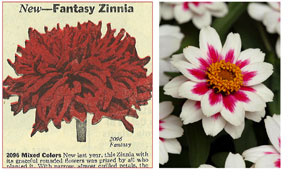2/21/2012
Growing Award-Winning Zinnias
Chris Schlegel
 In recognition of All-America Selections 80th anniversary,
In recognition of All-America Selections 80th anniversary, GrowerTalks
is featuring a series of Culture Notes articles on previous AAS winners during 2012.
The selection and performance of new zinnia varieties in recent years has prompted an increased use of this genus in gardens and landscapes. All-America Selections winners, including Profusion White, Magellan Coral and Zowie! Yellow Flame are a few of these outstanding zinnia varieties.
The first zinnia to win an AAS award was Fantasy Mix from Bodger in 1935 (left). Zahara Starlight Rose from PanAmerican Seed won the last award in 2010 (right).
Zinnia Profusion Cherry and Profusion Orange were awarded AAS Gold Medals in 1999. The result of an interspecific cross between
Z. angustifolia and
Z. elegans, they combined desirable characteristics from both types: heat and humidity tolerance, disease resistance, easy maintenance, compact growth and outstanding flowers. More recently Zahara Starlight Rose, Double Zahara Fire and Double Zahara Cherry were 2010 AAS Winners and represent even further improvements.
Propagation
Seed should be sown in well-drained media and covered lightly with media or vermiculite. A soil temperature of 76F (25C) is ideal. The media should be kept moist, but not soggy, since overly wet conditions will decrease the germination percentage.
Germination should occur within a week. After seedlings appear, the day temperatures should be 70F (21C) and night temperatures 65F (18C). From days 6 to 10 after sowing, they should be fertilized lightly with 50 to 100 ppm N and located in a well-ventilated and bright greenhouse.
From days 10 to 21 after sowing, the fertilizer rate should be increased to 100 to 150 ppm N and applied at least once a week.
B-Nine at a rate of 2,500 ppm is effective in holding back excessive growth. The seedlings should be ready to transplant in approximately 3 weeks depending on plug size. If the plugs need to be held, temperatures may be reduced, but should not fall below 60F (15C).
Light
Zinnias perform best in high-light situations. Be sure to avoid greenhouse areas that are shaded by infrastructure or numerous hanging baskets. We’ve found that a bright open roof-style greenhouse provides optimal conditions for finishing zinnias. The high light level and good air circulation are ideal.
Temperatures
The crop should be finished with temperatures in the 65F to 70F (18C to 21C) range. Temperatures that are below 60F (15C) may cause disease issues and those above 75F (24C) can result in stretch.
Media
A well-drained media, such as a peat/perlite mix, allows for good root development. The pH should be in the 5.5 to 6.2 range.
Irrigation and fertilization
Care must be taken to keep zinnias on the dry side. It’s also essential to keep the foliage as dry as possible, particularly late in the day. Systems such as ebb-and-flood benches are ideal for this crop.
Fertilizing at a rate of 200 ppm N with a complete fertilizer usually provides sufficient nutritional levels. The media EC should be in the range of 1 to 1.2 mmhos (2:1 slurry). Boron deficiency may occur with zinnias and symptoms include tip abortion, crinkled leaves and leaf-edge burn. Applying 0.25 ppm boron with fertilizer applications is suggested.
Pinching and PGRs
The newer varieties of zinnias generally branch well without pinching. If height control is needed, B-Nine is effective. Spacing the plants adequately and providing high-light levels will also limit the amount of stretch.
Pests and diseases
Watch for insect pests, such as aphids and thrips, particularly as the flowers develop. Be sure to read pesticide labels prior to application since there are commonly used products that may cause phytotoxicity on some zinnia varieties.
Perhaps more common problems occur as a result of fungal pathogens. While the newer varieties are more resistant, they still may be affected if conditions are conducive to disease. Botrytis and powdery mildew may appear, especially during dark or humid periods. Provide good air circulation and avoid overhead watering late in the day to limit problems. There are several highly effective fungicides available to aid in control. Be sure to properly rotate between chemical classes if spray applications are necessary.
Growing larger pot sizes of zinnias outside during the spring and summer months may be quite successful. However, there is obviously less control over the growing environment. Careful scouting for pests and diseases is even more imperative in this situation.
Pot sizes and crop times
Series such as Profusion and Zahara finish nicely in 4-in. through 6-in. sizes. Larger types such as Zowie! Yellow Flame and Magellan varieties are also excellent in larger patio containers.
4 in. (10 cm)— 6-7 weeks with 1 per pot
6 in. (15 cm)— 7-8 weeks with 3 per pot
Cell packs— 5-6 weeks
GT
Chris Schlegel is head grower for D.S. Cole Growers in Loudon, New Hampshire.